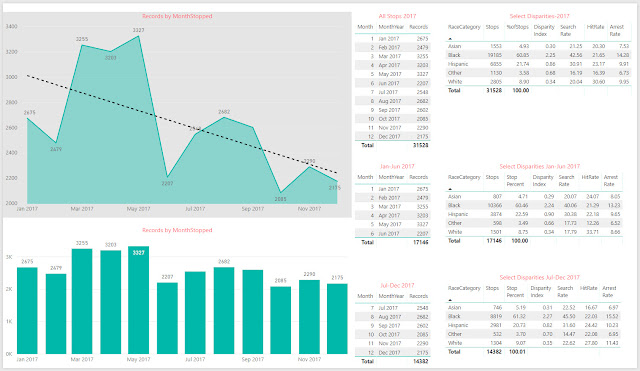RIPA them off or Baffle them with bullshit or Why deal with disparities when you can talk about footprints.
California’s Racial and Identity Profiling Advisory Board
Releases First
Annual Report
On January 1, 2018 the Attorney General’s Office released the First Annual Report; it left much
to be desired. I will not take this opportunity to be comprehensive in
criticism, instead I will be circumspect by addressing critical issues.
How to Determine the
“Denominator”[1]. This section of the report is
lifted from a boiler-plate that was crafted by beguilers; the section is tripe,
for it addresses stops alone (or should), even as it makes cursory
mention of other post-stop actions. All who examine stops will note that this “no
mean feat” only becomes a “feat” when the experiences on Blacks and Hispanics,
in all their inglorious abomination, “shine plain.” Only then is there a need for
“those analyzing the data must first take
into account factors that could legitimately explain and justify any apparent
differences that may be observed.” No explanation is possible. Even, if
there were merit to the report’s posit, the denominator for post-stop actions,
cannot be brought into question, as the board does. Moreover, your maths
teachers would be appalled by that which was presented by the Board. The
denominator is always the gross number, for the group being examined. Accordingly,
the Citation Rate for a group is the
number cited, divided by the number stopped, and those who say otherwise are
dunces.
The specious claim that Preliminary
data following policy changes for Oakland is “closing the gap.”
The
report, at page 53 claims that, with respect to the Oakland Police Department,
data- driven changes to its practices have created new policy. This policy resulted
in, “Preliminary data evaluating the new policy
suggests this policy change has been effective in closing the gap.”
This preliminary data appears to be based on an
evaluation by Benoit Monin of Stanford. Dr. Monin’s presentation material is here. On the last page,
Dr. Monin writes:
“More specifically, the
number of African Americans who were stopped with no ensuing citation or arrest
(one measure of the “policing footprint”) dropped from 6,420 to 5,259, also a
drop of 18%. In the footprint perspective, it is actually useful to eschew
percentages to see that in a 6-month period, 1,161 fewer African Americans were
stopped in non-traffic stops with no definitive police outcome. Whites see an
even larger percentage drop (-34%) as their footprint goes from 622 to 413, but
we see that in terms of impact on the community the numbers are much smaller.
Reducing disparities in policing outcomes is notoriously difficult because they
are multiply determined, including by sociological factors outside of the
police’s control.”
Some
may find something positive in 1,161 fewer constitutionally infirm stops of
Blacks; include me out for I am driven by Occam’s Razor[2] especially when the answer
lies plainly before me. Distilled
to its essentials, what we have happening with this footprint talk, is a reporting of fewer
stops. It should not be confused with having fewer stops.
The preliminary
evaluation of data, by Stanford, was premature.
At
the beginning of this month, several months after my making a request for the
data, the city of Oakland provided two datasets, which datasets contained many,
but not all, of the data elements that were used by the Stanford analysts. My
findings differ and are correct, although offset from Stanford by one month.
Even
though Stanford attempted to cast the outcome, of policy changes in positive
terms, the data merely disclosed that 1,161 fewer constitutionally-infirm stops of
Blacks had occurred. The Stanford analysts failed to mention that stops for two
commonly-used types or categories of actions are not in the data, and that that
fact more easily explains the ballyhooed reductions. Occam would not be amused;
I am not; not by the weasel-words. A preferable way to say Monin's last sentence is "
The
reduction in records was predicted, for it was easily predictable. I suppose
they, the Stanford analysts, did not notice or they preferred to speak of footprints. It should be left to the Stanford analysts
to determine just what data is missing. Let us leave them alone to figure it
out (even though I believe that they have but were hoping that we did not
notice.)
Doubtless,
you will notice that the disparities are ticking upward; ever so slightly
(something with which Dr. Monin seems to agree), as the reportable and reported records plummet.
A
report on Oakland Data that uses the recently received, defective and
non-compliant data is available
here. It is a work in progress.
A
voice-mail from Selina K Jones, a representative of the City of Oakland,
explains why the data sent to Stanford is so different from what has been
provided to this writer. It is evident that those who represent Oakland know
nothing about the Public Records Act. I will attempt to obtain instruction for
them.
[2] Occam's razor (also
Ockham's razor or Ocham's razor; Latin: lex
parsimoniae "law of parsimony") is the problem-solving principle
that, when presented with competing hypothetical answers to a problem, one
should select the answer that makes the fewest assumptions.

Comments
Post a Comment